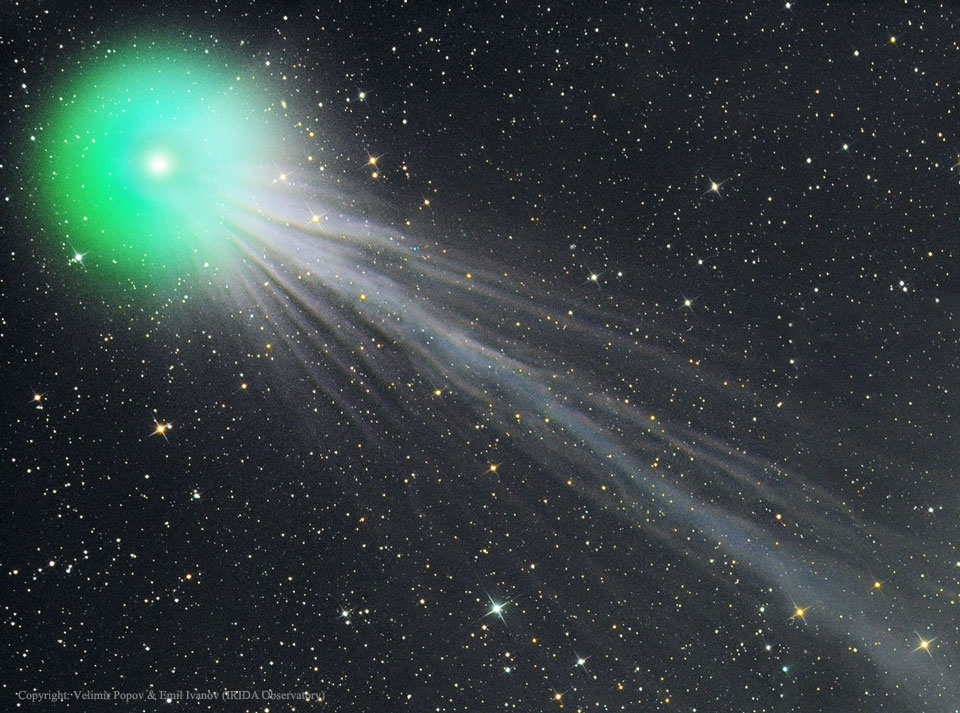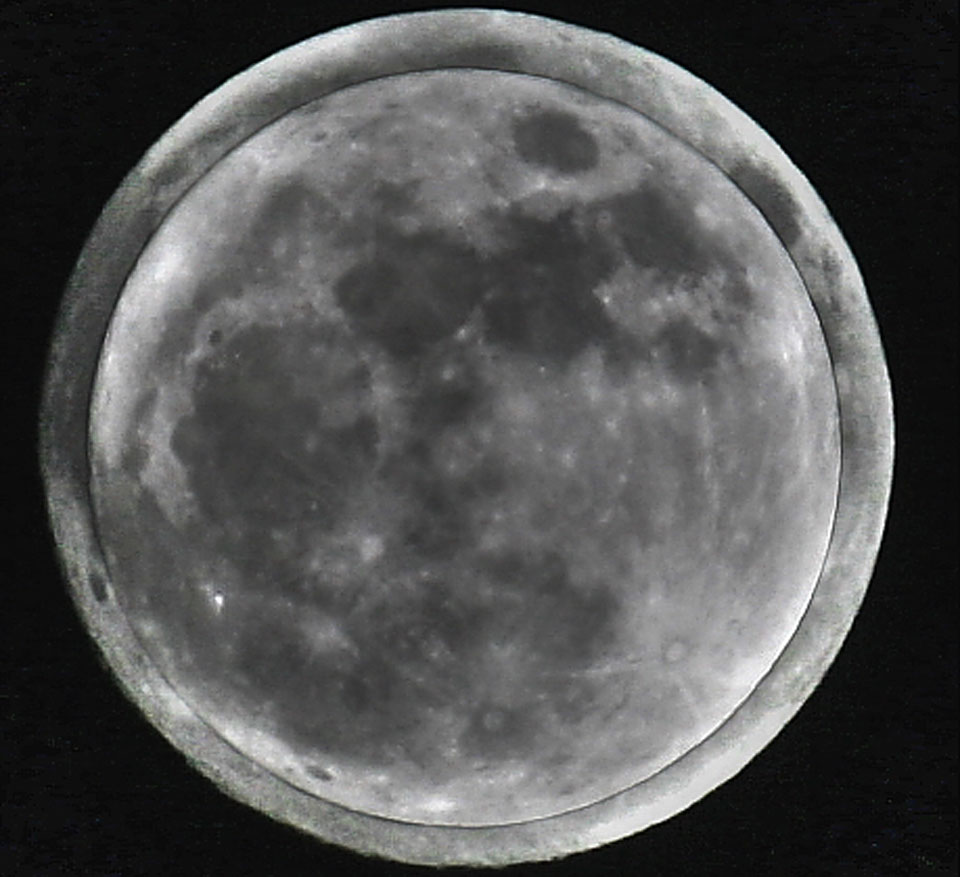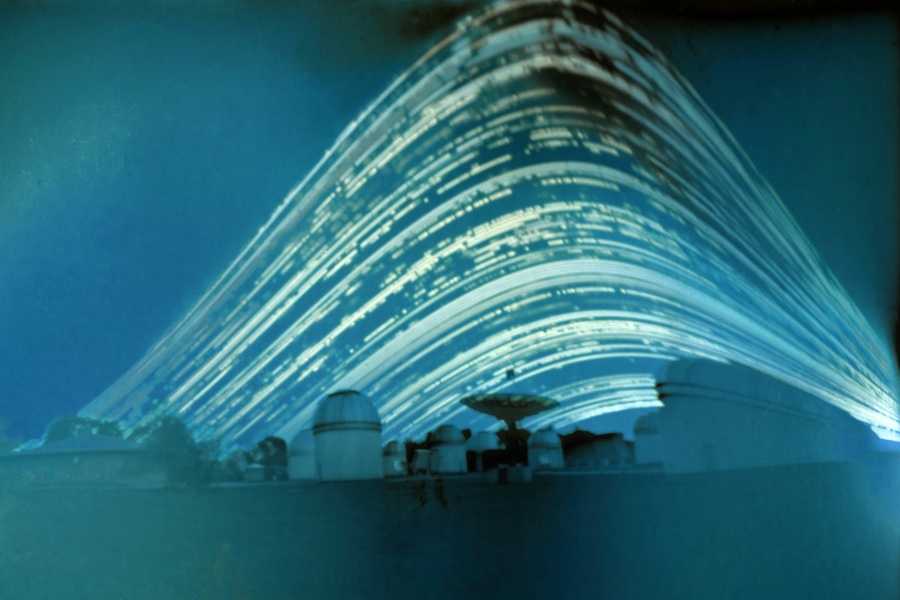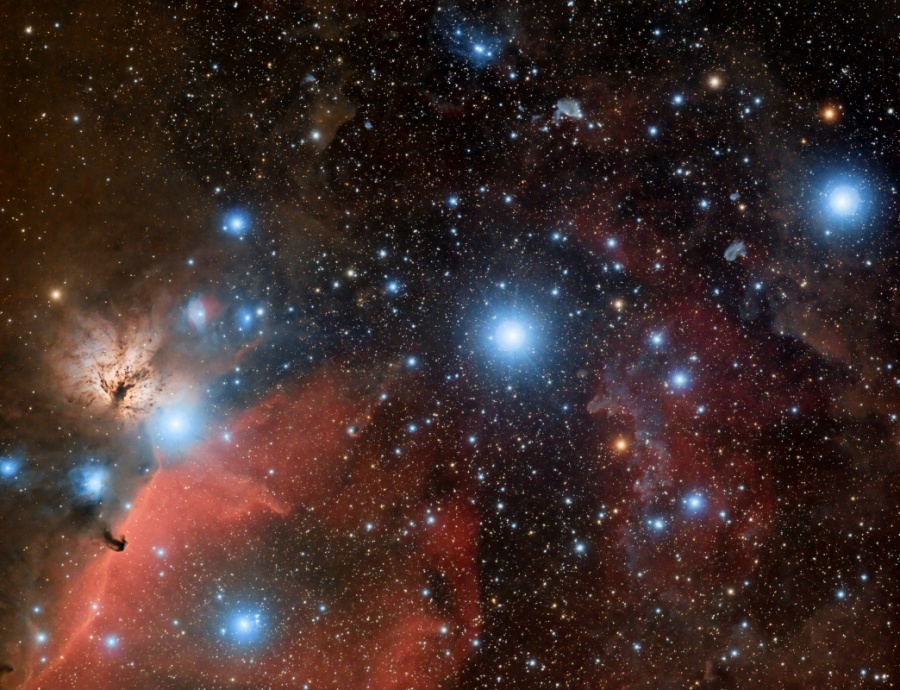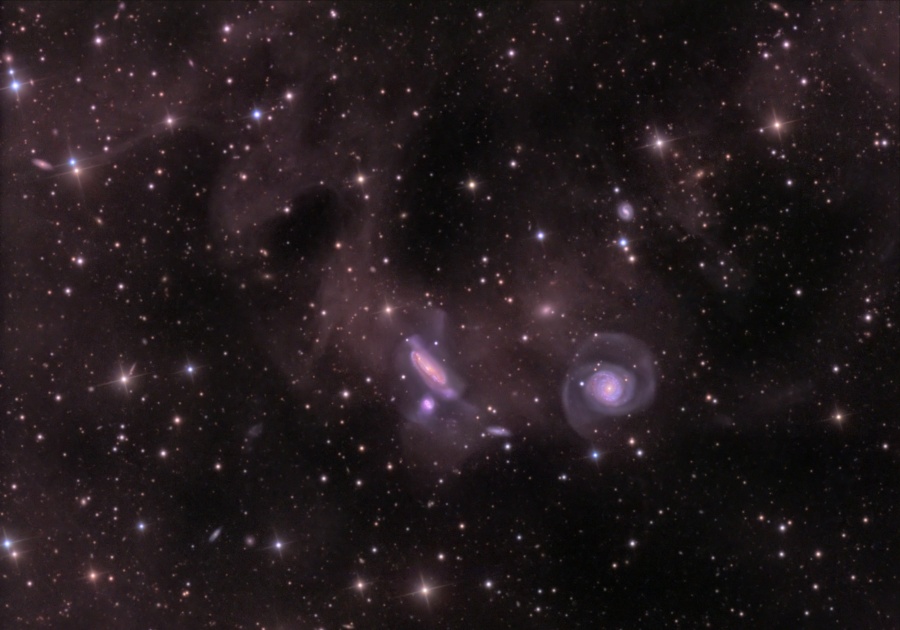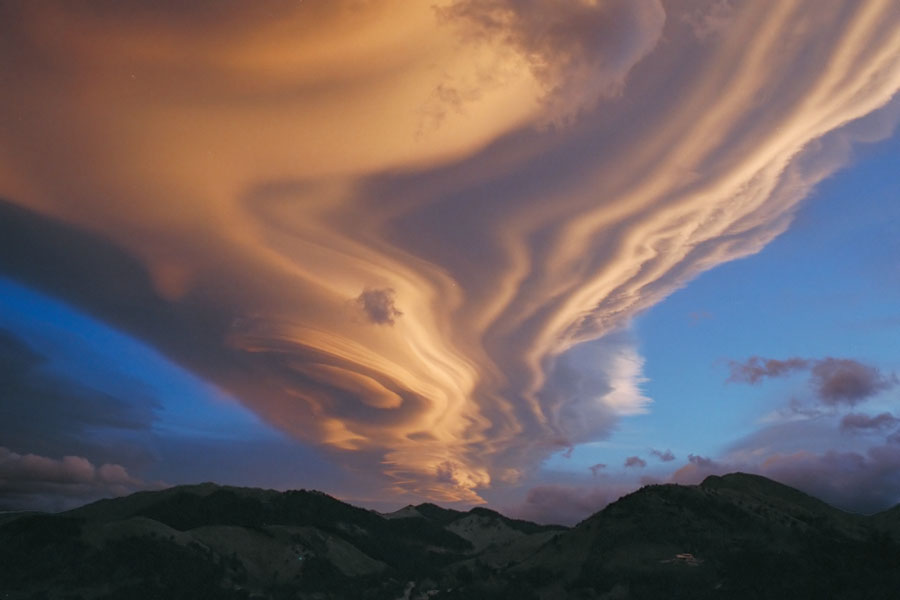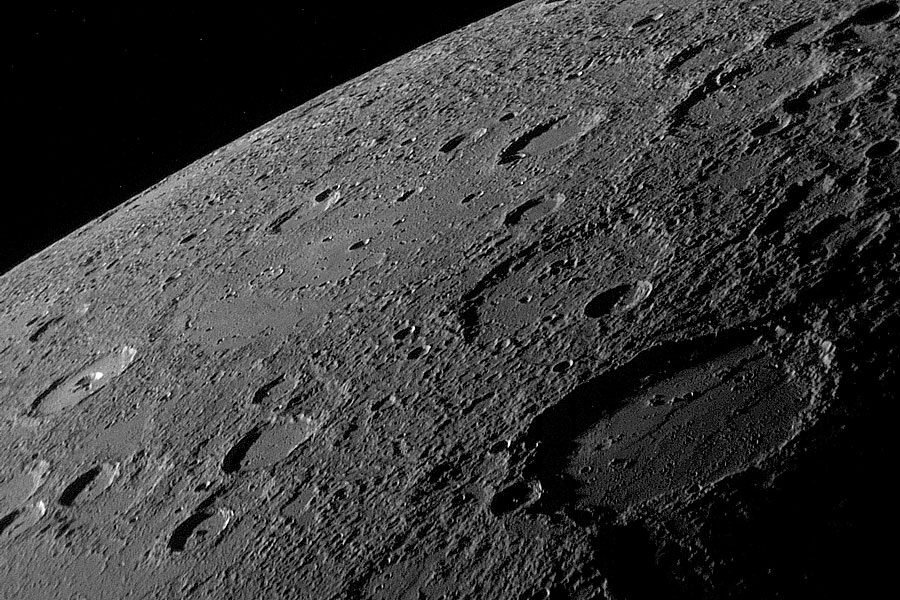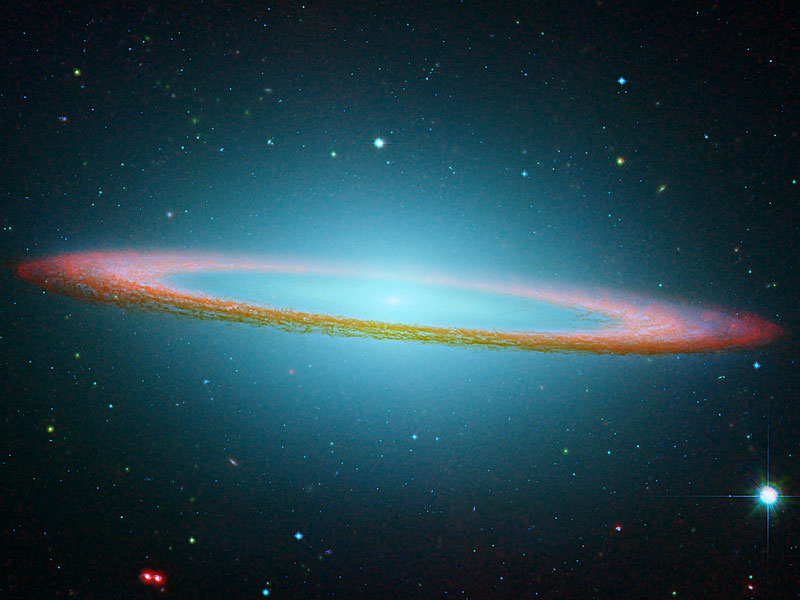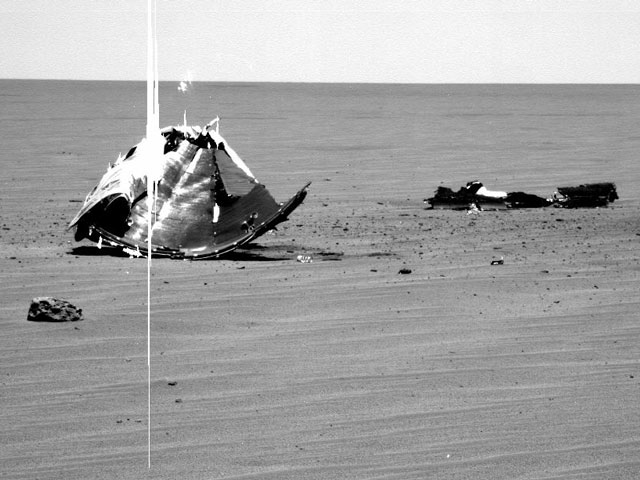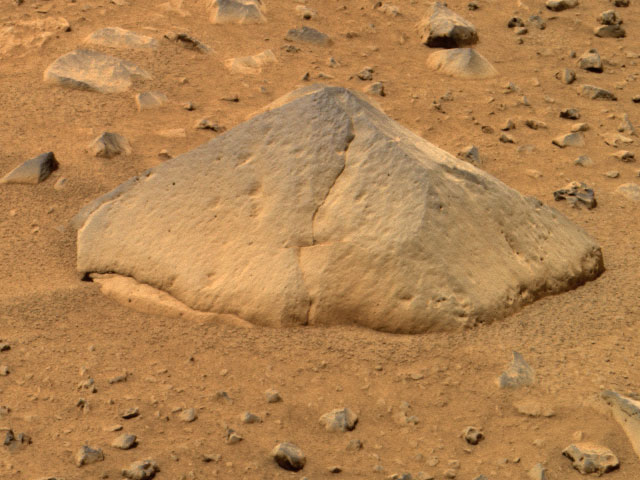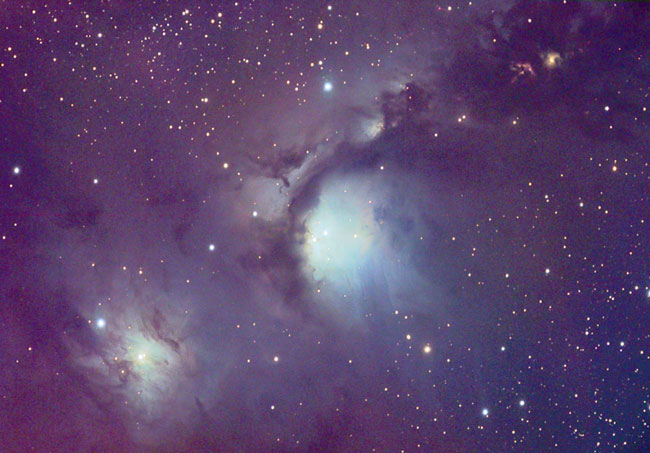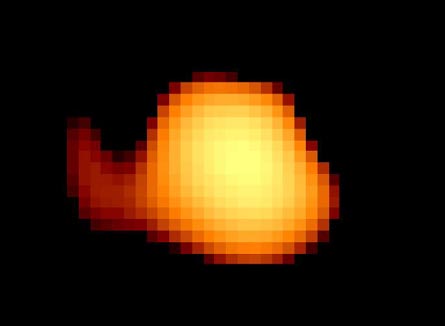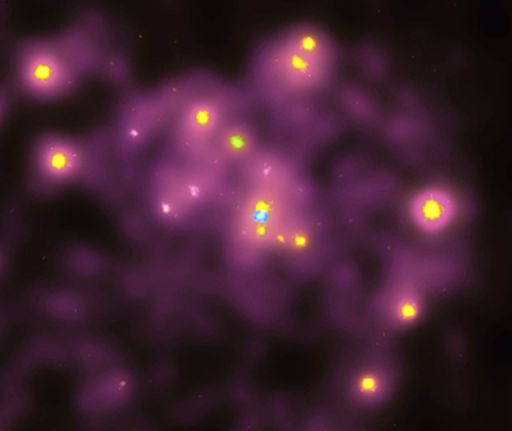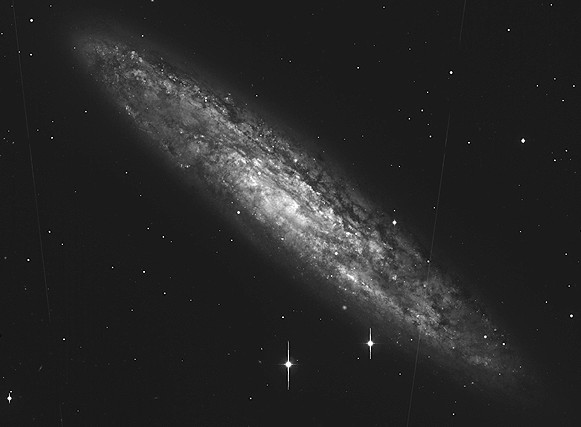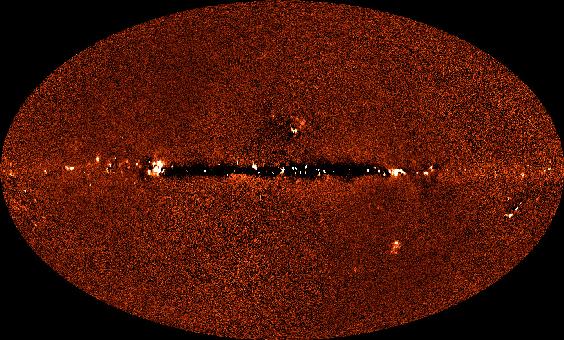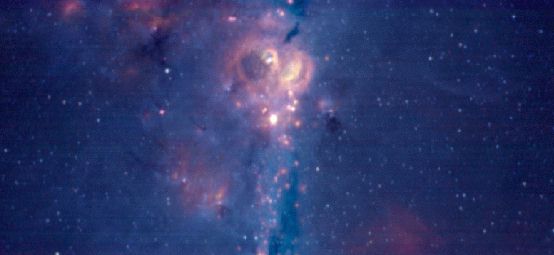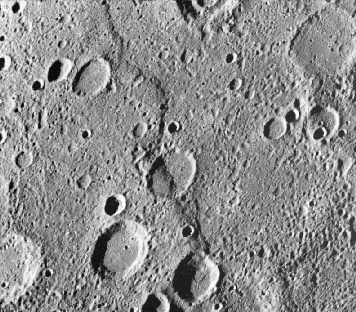| << Previous | Index | Next >> |
2015 What causes the structure in Comet Lovejoy's tail? Comet C/2014 Q2 (Lovejoy), which is currently at naked-eye brightness and near its brightest, has been showing an exquisitely detailed ion tail. As the name implies, the ion tail is made of ionized gas -- gas energized by ultraviolet light from the Sun and pushed outward by the solar wind. The solar wind is quite structured and sculpted by the Sun's complex and ever changing magnetic field. The effect of the variable solar wind combined with different gas jets venting from the comet's nucleus accounts for the tail's complex structure. Following the wind, structure in Comet Lovejoy's tail can be seen to move outward from the Sun even alter its wavy appearance over time. The blue color of the ion tail is dominated by recombining carbon monoxide molecules, while the green color of the coma surrounding the head of the comet is created mostly by a slight amount of recombining diatomic carbon molecules. The featured three-panel mosaic image was taken nine days ago from the IRIDA Observatory in Bulgaria. Comet Lovejoy made its closest pass to the Earth two weeks ago and will be at its closest to the Sun in about ten days. After that, the comet will fade as it heads back into the outer Solar System, to return only in about 8,000 years.
2014 Did you see the big, bright, beautiful Full Moon last Wednesday night? That was actually a Micro Moon! On that night, the smallest Full Moon of 2014 reached its full phase only a few hours from lunar apogee, the time of its the most distant point from Earth in the Moon's elliptical orbit. Of course, last year on the night of June 22, a Full Super Moon was near perigee, the closest point in its orbit. The relative apparent size of January 15's Micro Moon is compared to the June 22 Super Moon in the above composite image digitally superimposing telescopic images from Perugia, Italy. The difference in apparent size represents a difference in distance of just under 50,000 kilometers between apogee and perigee, given the Moon's average distance of about 385,000 kilometers. How long do you have to wait to see another Full Micro Moon? Until March 5, 2015, when the lunar full phase will again occur within a few hours of lunar apogee.
2013
Click to play embedded YouTube video.
Credit: ESA/NASA/JPL/U. Arizona; Music: Beethoven's Piano Concerto #4; YouTube Upload: djxatlanta
2012 From solstice to solstice, this six month long exposure compresses time from the 21st of June till the 21st of December, 2011, into a single point of view. Dubbed a solargraph, the unconventional picture was recorded with a pinhole camera made from a drink can lined with a piece of photographic paper. Fixed to a single spot for the entire exposure, the simple camera continuously records the Sun's path each day as a glowing trail burned into the photosensitive paper. In this case, the spot was chosen to look out over the domes and radio telescope of the University of Hertfordshire's Bayfordbury Observatory. Dark gaps in the daily arcs are caused by cloud cover, whereas continuous bright tracks record glorious spells of sunny weather. Of course, in June, the Sun trails begin higher at the northern hemisphere's summer solstice. The trails sink lower in the sky as December's winter solstice approaches. Last year's autumn was one of the balmiest on record in the UK, as the many bright arcs in the lower part of this picture testify.
2011 Alnitak, Alnilam, and Mintaka, are the bright bluish stars from east to west (left to right) along the diagonal in this gorgeous cosmic vista. Otherwise known as the Belt of Orion, these three blue supergiant stars are hotter and much more massive than the Sun. They lie about 1,500 light-years away, born of Orion's well-studied interstellar clouds. In fact, clouds of gas and dust adrift in this region have intriguing and some surprisingly familiar shapes, including the dark Horsehead Nebula and Flame Nebula near Alnitak at the lower left. The famous Orion Nebula itself lies off the bottom of this colorful star field. Recorded last December with a modified digital SLR camera and small telescope, the well-planned, two frame mosaic spans about 4 degrees on the sky.
2010 Galaxies of the NGC 7771 Group are featured in this intriguing skyscape. Some 200 million light-years distant toward the constellation Pegasus, NGC 7771 is the large, edge-on spiral near center, about 75,000 light-years across, with two smaller galaxies just below it. Large spiral NGC 7769 is seen face-on to the right. Galaxies of the NGC 7771 group are interacting, making repeated close passages that will ultimately result in galaxy-galaxy mergers on a cosmic timescale. The interactions can be traced by galaxy distortions and faint streams of stars created by gravitational tides. But a clear view of the galaxy group is difficult to come by, as the deep image also reveals extensive clouds of foreground dust sweeping across the field. The dim, dusty nebulae reflect starlight from our own Milky Way Galaxy and lie only a few hundred light-years above the galactic plane.
2009 What's happening above those mountains? Several clouds are stacked up into one striking lenticular cloud. Normally, air moves much more horizontally than it does vertically. Sometimes, however, such as when wind comes off of a mountain or a hill, relatively strong vertical oscillations take place as the air stabilizes. The dry air at the top of an oscillation may be quite stratified in moisture content, and hence forms clouds at each layer where the air saturates with moisture. The result can be a lenticular cloud with a strongly layered appearance. The above picture was taken in 2002 looking southwest over the Tararua Range mountains from North Island, New Zealand.
2008 What would it look like to fly past Mercury? Just such an adventure was experienced last week by the MESSENGER spacecraft during its first flyby of the strange moon-like world nearest the Sun. Pictured above is the limb of Mercury seen by MESSENGER upon approach, from about 1 1/2 Earth diameters away. Visible on the hot and barren planet are many craters, many appeared to be more shallow than similarly sized craters on the Moon. The comparatively high gravity of Mercury helps flatten tall structures like high crater walls. MESSENGER was able to take over 1,000 images of Mercury which will be beamed back to Earth for planetary geologists to study. The robotic MESSENGER spacecraft is scheduled to fly past Mercury twice more before firing its thrusters to enter orbit in 2011.
2007 This floating ring is the size of a galaxy. In fact, it is part of the photogenic Sombrero Galaxy, one of the largest galaxies in the nearby Virgo Cluster of Galaxies. The dark band of dust that obscures the mid-section of the Sombrero Galaxy in optical light actually glows brightly in infrared light. The above image shows the infrared glow, recently recorded by the orbiting Spitzer Space Telescope, superposed in false-color on an existing image taken by NASA's Hubble Space Telescope in optical light. The Sombrero Galaxy, also known as M104, spans about 50,000 light years across and lies 28 million light years away. M104 can be seen with a small telescope in the direction of the constellation Virgo.
2006 In November of 1969, Apollo 12 astronaut-photographer Charles "Pete" Conrad recorded this masterpiece while documenting colleague Alan Bean's lunar soil collection activities on the Oceanus Procellarum. The image is dramatic and stark. The harsh environment of the Moon's Ocean of Storms is echoed in Bean's helmet, a perfectly composed reflection of Conrad and the lunar horizon. Is it art? Works of photojournalists originally intent on recording the human condition on planet Earth, such as Lewis W. Hine's images from New York City in the early 20th century, or Margaret Bourke-White's magazine photography are widely regarded as art. Similarly many documentary astronomy and space images can be appreciated for their artistic and esthetic appeal.
2005 What has the Opportunity rover found on Mars? While traversing a vast empty plain in Meridiani Planum, one of Earth's yearling rolling robots found a surprise when visiting the location of its own metallic heat shield discarded last year during descent. The surprise is the rock visible on the lower left, found to be made mostly of dense metals iron and nickel. The large cone-shaped object behind it -- and the flank piece on the right -- are parts of Opportunity's jettisoned heat shield. Smaller shield debris is also visible. Scientists do not think that the basketball-sized metal "Heat Shield Rock" originated on Mars, but rather is likely an ancient metallic meteorite. In hindsight, finding a meteorite in a vast empty dust plain on Mars might be considered similar to Earth meteorites found on the vast empty ice plains of Antarctica. The finding raises speculations about the general abundance of rocks on Mars that have fallen there from outer space.
2004 Is this a great pyramid on Mars? Actually, the pictured rock dubbed Adirondack has an irregular shape, is only about the size of a football, and has formed by natural processes. Still, its relatively large size and dust-free surface made it the first destination for the robotic Spirit rover currently roving Mars. Spirit, itself the size of a golf cart, will now attempt to determine the rock's composition and history by prodding it with its sophisticated mechanical arm. Spirit's arm, programmed remotely from Earth, has the capability to bend, grind, and photograph the rock in minute detail. Spirit's twin rover Opportunity is scheduled to land on the other side of Mars this coming weekend.
2003 In the vast Orion Molecular Cloud complex, several bright blue nebulas are particularly apparent. Pictured above are two of the most prominent reflection nebulas - dust clouds lit by the reflecting light of bright embedded stars. The more famous nebula is M78, on the upper right, cataloged over 200 years ago. On the lower left is the lesser known NGC 2071. Astronomers continue to study these reflection nebulas to better understand how interior stars form. The Orion complex lies about 1500 light-years distant, contains the Orion and Horsehead nebulas, and covers much of the constellation of Orion.
2002 Sometimes both heaven and Earth erupt. In Iceland in 1991, the volcano Hekla erupted at the same time that auroras were visible overhead. Hekla, one of the most famous volcanoes in the world, has erupted at least 20 times over the past millennium, sometimes causing great destruction. The last eruption occurred only two years ago but caused only minor damage. The green auroral band occurred fortuitously about 100 kilometers above the erupting lava. Is Earth the Solar System's only planet with both auroras and volcanos?
2001 Most stars appear only as points of light. In 1995, Betelgeuse became the second star, after our Sun, to have it surface resolved. Later that year, Mira was added to the list. Mira A is a red giant star undergoing dramatic pulsations, causing it to become more than 100 times brighter over the course of a year. Mira was discovered to be the first variable star about 400 years ago by David Fabricus. Mira can extend to over 700 times the size of our Sun, and is only 400 light-years away. The above photograph taken by the Hubble Space Telescope shows the true face of Mira. But what are we seeing? The unusual extended feature off the lower left of the star remains somewhat mysterious. Possible explanations include gravitational perturbation and/or heating from Mira's white dwarf star companion.
2000 A big beautiful spiral galaxy 2 million light-years away, Andromeda (M31) has long been touted as an analog to the Milky Way, a distant mirror of our own galaxy. The popular 1960s British sci-fi series, A For Andromeda, even postulated that it was home to another technological civilization that communicated with us. Using the newly unleashed observing power of the orbiting Chandra X-ray telescope, astronomers have now imaged the center of our near-twin island universe, finding evidence for an object so bizarre it would have impressed many 60s science fiction writers (and readers). Like the Milky Way, Andromeda's galactic center appears to harbor an X-ray source characteristic of a black hole of a million or more solar masses. Seen above, the false-color X-ray picture shows a number of X-ray sources, likely X-ray binary stars, within Andromeda's central region as yellowish dots. The blue source located right at the galaxy's center is coincident with the position of the suspected massive black hole. While the X-rays are produced as material falls into the black hole and heats up, estimates from the X-ray data show Andromeda's central source to be surprisingly cool - only a million degrees or so compared to the tens of millions of degrees indicated for Andromeda's X-ray binaries.
1999 A camera with over 67 million pixels (digital picture elements) was used to record this stunning image of spiral galaxy NGC 253. Known as the Wide Field Imager (WFI), the camera is the latest instrument to be installed at the European Southern Observatory's 2.2 meter telescope in La Silla, Chile. Constructed from exposures made by the WFI in December 1998, this picture has been cropped from the full field to emphasize the galaxy and contrast adjusted to follow the graceful, winding arms and dramatic dust lanes of this photogenic island universe. Relatively bright foreground stars produce the sharp vertical streaks seen here while higher resolution versions of the image show intriguing, faint, background galaxies and likely globular star clusters associated with NGC 253. Two faint satellite trails are also visible. NGC 253, an Sc type spiral, is about 8 million light-years away in the southern constellation Sculptor.
1998 What's black & white and red all over? Add our universe to this list. Adrift in a vast sea of darkness are not only familiar bright stars but dust that glows predominantly in far-infrared light. This cosmological dust was recently discovered in data taken previously by the COBE satellite, and visible as a diffuse glow visible in the above image. The amount of dust in the universe is important because it is a measure of the number of stars that created it, of the number of stars that are cloaked by it, and of the amount of distortion created in measurements of the distant universe.
1997 In Jules Verne's science fiction classic A Journey to the Center of the Earth, Professor Hardwigg and his fellow explorers encounter many strange and exciting wonders. What wonders lie at the center of our Galaxy? Astronomers now know of some of the bizarre objects which exist there, like vast dust clouds, bright young stars, swirling rings of gas, and possibly even a large black hole. Much of the Galactic center region is shielded from our view in visible light by the intervening dust and gas. But it can be explored using other forms of electromagnetic radiation, like radio, infrared, X-rays, and gamma rays. This beautiful high resolution image of the Galactic center region in infrared light was made by the SPIRIT III telescope onboard the Midcourse Space Experiment. The center itself appears as a bright spot near the middle of the roughly 1x3 degree field of view, the plane of the Galaxy is vertical, and the north galactic pole is towards the right. The picture is in false color - starlight appears blue while dust is greenish grey, tending to red in the cooler areas.
1996 The surface of the planet Mercury is not without fault. In this case, however, "fault" refers to unusual surface features that are the topic of much speculation. The above fault line is called Santa Maria Rupes, and runs through many prominent craters. The meandering feature is thought to be the result of huge forces of compression on Mercury's surface. Such rupes probably originate from large impacts and a general shrinking of Mercury's crust, which in turn causes parts of the crust to push above other parts.
| << Previous | Index | Next >> |
